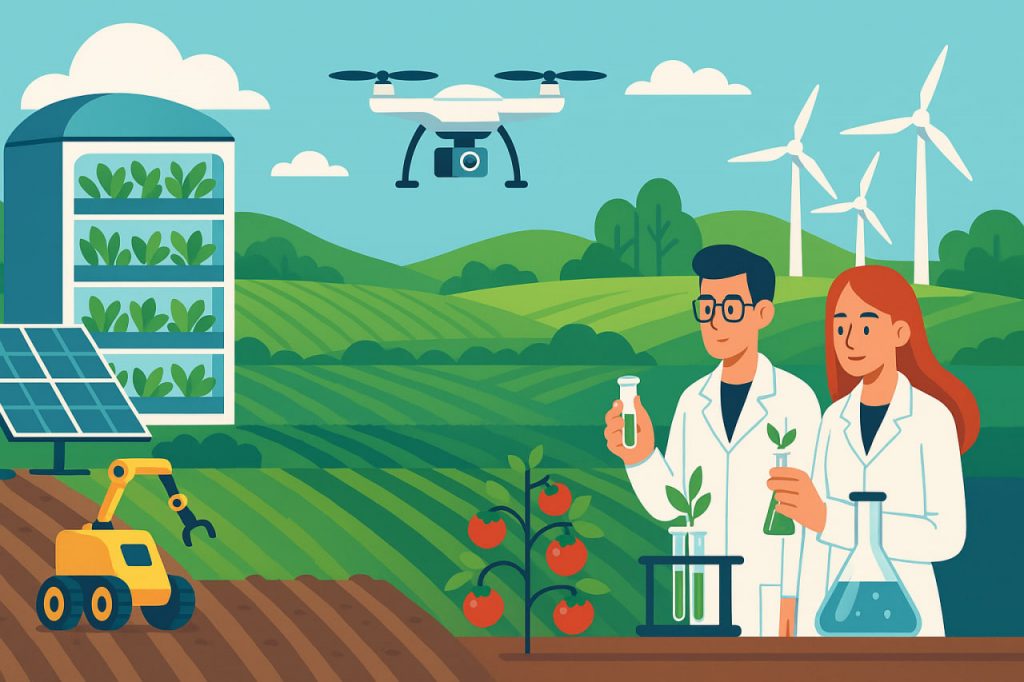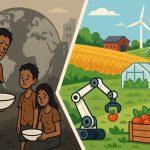As the global population moves toward 10 billion by 2050, humanity faces one of its greatest challenges — how to feed everyone sustainably. Traditional agriculture, already strained by climate change, water scarcity, and soil degradation, cannot meet future demands without technological transformation. Fortunately, new scientific innovations are reshaping the way we grow, distribute, and consume food, bringing hope for a world without hunger.
The Scale of the Challenge
Global food production must increase by 60–70% to feed the growing population. However, expanding farmland is no longer a viable solution. Forest loss, declining freshwater reserves, and greenhouse gas emissions make it essential to produce more food with fewer resources. This has led to a wave of innovations in biotechnology, artificial intelligence, and sustainable farming.
Smart Agriculture and Artificial Intelligence
AI is revolutionizing food production by optimizing every stage of farming. Using satellite imagery, drones, and sensors, farmers can monitor soil health, detect crop diseases early, and predict harvest yields with unprecedented accuracy.
- Precision agriculture enables farmers to use only the exact amount of water, fertilizer, or pesticide required — minimizing waste and environmental harm.
- Autonomous tractors and harvest robots perform tasks more efficiently than humans, even in harsh conditions.
- AI-based forecasting helps governments and companies anticipate food shortages and manage supply chains effectively.
These technologies are already being implemented in large agricultural nations such as the United States, China, and the Netherlands, setting the foundation for a digital farming revolution.
Vertical Farming and Urban Agriculture
As cities grow, food production is moving indoors. Vertical farms — high-tech facilities where crops grow in stacked layers — use LED lighting, hydroponics, and climate control systems to produce food year-round with minimal land and water.
Compared to traditional agriculture, vertical farming uses:
- 90% less water
- 80% less land
- No pesticides or harmful chemicals
Urban agriculture also reduces the distance food travels from farm to table, cutting carbon emissions and ensuring fresher produce. Countries like Japan and Singapore are leading in urban farming innovation, building entire skyscrapers dedicated to food production.
Genetic Engineering and Bioinnovation
Advances in biotechnology are reshaping crops to resist drought, disease, and pests. Using CRISPR gene-editing technology, scientists can modify plants to thrive in poor soils, tolerate heat, and retain more nutrients.
For instance:
- Drought-resistant maize is helping African farmers survive extreme weather.
- Golden rice has been engineered to contain vitamin A, reducing malnutrition in Asia.
- Nitrogen-fixing cereals may soon eliminate the need for chemical fertilizers.
Meanwhile, researchers are developing lab-grown meat, cell-based milk, and plant-based proteins that replicate the taste and nutrition of traditional animal products while reducing environmental impact.
Water-Efficient and Climate-Resilient Systems
Water scarcity affects more than 40% of the global population. To address this, engineers are creating innovative irrigation and desalination systems.
- Drip irrigation delivers water directly to plant roots, cutting waste dramatically.
- Atmospheric water generators extract moisture from air to irrigate crops in arid regions.
- Climate-controlled greenhouses shield plants from extreme weather and optimize growth using renewable energy.
Such systems are being tested in regions like the Middle East and North Africa, where agriculture must adapt to extreme heat and limited rainfall.
Food Waste Reduction and Circular Economy
Around 30% of global food production is lost or wasted annually. Startups and governments are tackling this problem through:
- Smart packaging that changes color when food is about to spoil.
- Blockchain systems that track food from farm to consumer, ensuring transparency.
- Bioconversion technologies that turn organic waste into animal feed, compost, or biofuel.
In the circular economy of the future, no food will go to waste — it will be recycled back into the production cycle.
Alternative Proteins and Sustainable Diets
Feeding billions sustainably requires shifting from traditional livestock, which accounts for nearly 15% of global greenhouse emissions, to alternative sources of protein.
Innovations include:
- Insect protein, used in flours and animal feed.
- Algae-based food, rich in vitamins and omega-3 fatty acids.
- Fermentation-derived proteins, created by microbes that “brew” nutrients similarly to how yeast makes beer.
These methods can provide nutritious food with a fraction of the environmental footprint of meat and dairy farming.
The Role of Global Cooperation
Technological innovation alone cannot solve the food crisis. Governments, private companies, and citizens must work together to ensure fair access to these advances. Supporting education, small farmers, and local food systems will help communities worldwide become more resilient.
International programs like the UN Food Systems Summit and FAO’s Green Cities Initiative promote sustainable agricultural innovation across developing nations, bridging the gap between science and daily life.
Interesting Facts
- The world’s largest vertical farm in the U.S. produces 2 million pounds of greens annually using only LED light.
- Lab-grown meat requires 90% less land and water than traditional farming.
- AI systems can increase crop yields by up to 30% through predictive analysis.
- Algae farms can absorb CO₂ while producing high-protein food and biofuel.
Glossary
- CRISPR — a gene-editing technology used to modify DNA with precision.
- Hydroponics — growing plants in nutrient-rich water instead of soil.
- Vertical farming — cultivating crops in stacked indoor layers using artificial light.
- Atmospheric water generator — a device that extracts clean water from air humidity.
- Circular economy — a system where resources are reused and recycled to minimize waste.


